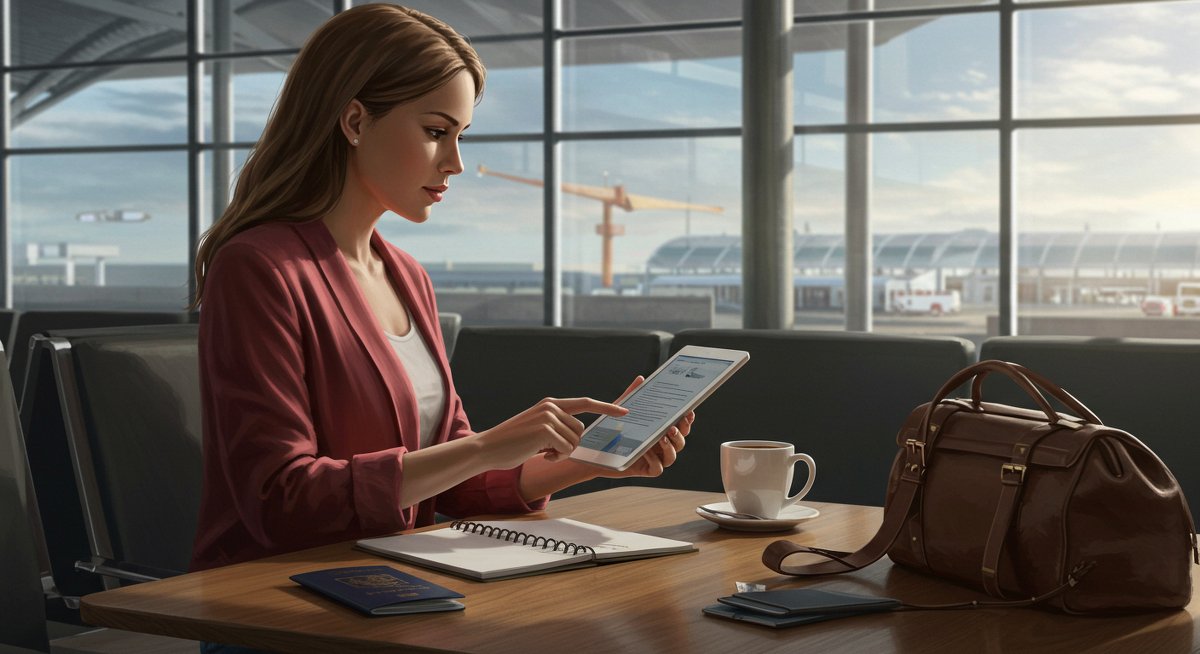Visa applications can feel like deciphering a secret code, especially on your first international trip. This guide is designed for beginners like you, breaking down each step to make it straightforward. We'll cover the basics and help you avoid common pitfalls, so you can confidently start your international adventure in 2025. Get ready to explore the world – one visa at a time!

Why This Matters for New Travellers
The visa process can seem intimidating. The paperwork, the waiting, the potential for rejection – it’s enough to make anyone’s head spin. Understanding visas is crucial for safe and legal international travel. Without the right visa, you might be denied entry, face fines, or even be prevented from returning home. This guide will provide you with the knowledge to navigate this process with confidence. A little preparation goes a long way. Many travellers miss out on experiences simply because they didn't understand the visa requirements. This guide will help you avoid that and enjoy your trip.
Getting Started: What You Need to Know
Before filling out an application, understand the basics. First, determine if you actually need a visa. This depends on your nationality, the country you're visiting, and the purpose of your trip (tourism, business, study, etc.). Many countries offer visa-free entry to citizens of certain nations for tourism, while others require visas for almost all countries. Always check the specific requirements of the country you plan to visit well in advance. You can find this information on the official website of the embassy or consulate of your destination country. Another helpful resource is the travel section of your home country's government website. Also check for any travel advisories or alerts that might affect your visa application or travel plans. Rules can change, so always verify the latest information.
Step-by-Step Solution
Here's a framework to guide you through the visa application process:
Step 1: Determine Your Visa Needs:
- Identify Your Destination: Which country are you visiting? For how long? What's the purpose of your trip?
- Check Visa Requirements: Visit the official website of the embassy or consulate of the country you plan to visit. This is your primary source of truth. You can also find information on your home country's travel advisory website.
- Understand Visa Types: Tourism visas are the most common. Others include student, work, business, and transit visas. Make sure you apply for the right one.
Step 2: Gather Required Documents:
- Passport: Ensure your passport is valid for at least six months beyond your intended stay. Check for sufficient blank pages.
- Application Form: Download and complete the visa application form. Follow all instructions carefully.
- Passport Photos: Usually, you'll need passport-sized photos that meet specific requirements (size, background, etc.).
- Travel Itinerary: This often includes flight bookings, hotel reservations, and a detailed daily plan.
- Financial Documents: Bank statements, proof of funds, and sometimes a letter of sponsorship if someone is supporting your trip.
- Supporting Documents: This could include a letter of invitation (for business or visiting family), a letter of acceptance (for students), or proof of employment.
Step 3: Complete the Application Form:
- Accuracy is Key: Fill out the form completely and truthfully. Any errors or omissions can lead to delays or rejection.
- Follow Instructions: Carefully read and adhere to all instructions provided by the embassy or consulate.
- Be Organized: Keep copies of everything. Organize your documents in a logical order.
Step 4: Submit Your Application:
- Methods: Applications are often submitted online, by mail, or in person at the embassy or consulate. Follow the instructions for your specific destination.
- Fees: Be prepared to pay a visa application fee. Fees vary depending on the country and visa type.
- Interviews: Some countries require an interview as part of the application process. Be prepared to answer questions about your travel plans.
Step 5: Wait for a Decision:
- Processing Times: Visa processing times vary. Plan well in advance and apply as early as possible (typically several weeks to months before your trip).
- Track Your Application: Many embassies offer online tools to track the status of your application.
- Decision: You'll receive a notification (email, mail, etc.) about the decision on your visa application.
Step 6: If Approved, Prepare for Travel
- Review Your Visa: Check the dates of validity, entry conditions, and any restrictions. Make sure everything aligns with your travel plans.
- Keep Documents Handy: Carry a copy of your visa and passport with you at all times while travelling. Have your travel itinerary readily available.
Your First $[Amount]: What to Expect
Applying for a visa involves costs. Visa fees vary considerably. In the US, fees range from around $20 to $200, and can be even higher for some visas or specific countries. Always check the official embassy website to find the exact fee. Consider also the cost of passport photos, which usually run from $10 to $20. Factor in the cost of certified translations of documents if required (prices vary depending on length and language, from $20-$50 per page). And, if you hire a visa agency, expect to pay extra for their services (fees range from $50-$200+). Remember, these are just estimates. The total cost will depend on your nationality, destination, and specific visa requirements.
Example 1: Imagine you’re a U.S. citizen applying for a tourist visa to visit the UK. The visa fee is currently around $130 USD. You’ll also need to pay for passport photos ($15) and potentially travel insurance (another $50-$100 depending on the duration of your trip), bringing your total estimated costs to around $195-$245.
Example 2: If you're applying for a Schengen visa (to visit countries in the Schengen Area), the visa fee is about €80 (around $85 USD). Additional costs might include travel insurance ($50-$100), and certified translations of documents.
Example 3: If you're a student applying for an F-1 visa to study in the US, the fee is about $185. You'll also need to account for costs like the SEVIS fee (around $350), and the cost of your visa photos. It's a good idea to set aside a buffer, just in case. Unexpected fees do pop up. Being prepared helps keep your travel plans on track. Don't forget to also factor in the costs of flights, hotels and spending money when budgeting for your trip. A budget can help you manage all the aspects of your trip.
Common Beginner Mistakes to Avoid
Visa applications are prone to common pitfalls. Here are a few to watch out for:
- Applying Too Late: Start the process as early as possible – ideally, months before your trip.
- Incomplete Applications: Ensure all required fields are filled out correctly and all documents are included.
- Incorrect Information: Double-check everything – dates, names, addresses – for accuracy.
- Expired Passports: Make sure your passport is valid for at least six months beyond your planned return date.
- Not Understanding the Requirements: Carefully review all guidelines from the embassy or consulate.
- Ignoring the Fine Print: Read all instructions and requirements carefully.
- Lack of Proof of Funds: Provide sufficient evidence of your financial ability to support your trip.
- Missing the Interview: If an interview is scheduled, attend it and be prepared to answer questions honestly.
- Ignoring Travel Insurance: It's important to have travel insurance.

International Travel Considerations
Applying for a visa is just one part of preparing for international travel. There are several other important factors to consider:
- Travel Insurance: Ensure you have comprehensive travel insurance that covers medical emergencies, trip cancellations, and lost or stolen items. This is a must for any international traveller, no matter your experience level.
- Health and Vaccinations: Research recommended vaccinations and health precautions for your destination. Visit your doctor well in advance of your trip.
- Currency Exchange: Familiarize yourself with the local currency and exchange rates. It’s often best to exchange currency at your bank or a reputable exchange service before you leave. Be careful of excessive fees.
- Communication: Ensure you have a way to communicate (phone, data plan, Wi-Fi) to stay connected with family, friends, or in case of emergencies.
- Cultural Sensitivity: Be respectful of local customs and traditions. Research the etiquette of the country you're visiting.
- Safety: Know the emergency contact numbers for the country you are visiting. Make copies of important documents, and keep them separate from the originals.
Building Your Travel Knowledge
- Research Your Destination: Learn about the culture, customs, and local laws of the country you are visiting.
- Join Travel Communities: Connect with other travellers online or in person to gain valuable insights and advice.
- Utilize Online Resources: Numerous websites and blogs provide information about visa requirements, travel tips, and destination guides.
- Subscribe to Travel Alerts: Sign up for alerts from your government's travel advisory to stay updated on any safety concerns or travel warnings.
Next Steps in Your Travel Journey
You’ve taken the first step! Applying for your first international visa might seem daunting, but armed with this guide, you are well on your way. Remember, preparation is key. Double-check all requirements, gather your documents, and apply well in advance of your travel dates. Take a deep breath, and enjoy the process. The world awaits!
If you’re on this journey too, I’d love to hear how it goes for you. Share your experiences and any tips you’ve learned. Safe travels!